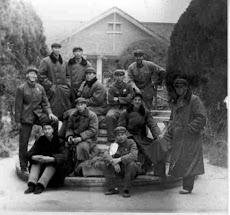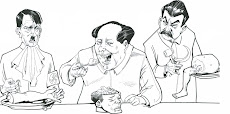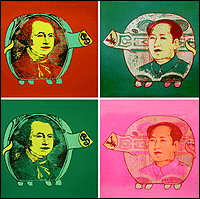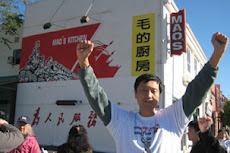 陈凯一语:
陈凯一语: 专制文化与自由文化的区别在于: 自由文化将腐败作为腐败堕落去制裁;专制文化将腐败作为贤明智慧去褒扬。 将政府与先贤(而不是将God)作为道德的来源是中文系人们腐败的死结。
Kai Chen's Words:
The difference between a culture of freedom and a culture of despotism is such that in a culture of freedom, corruption is treated/viewed and punished as corruption, while in a culture of despotism, corruption is espoused/extolled and propagated as virtue and wisdom. Taking Not God,but government and ancestors as the origin of morality, is the origin of all evil in China.
陈凯博客: www.kaichenblog.blogspot.com
----------------------------------------------------
SUN WUKONG
Corruption in the Name of Culture
中国文化的实质是腐败 - 用文化名义散布腐败
By Wu Zhong, China Editor
HONG KONG - Mengzi (372- 289 BC) is perhaps the second-greatest scholar in ancient China after Confucius (551-479 BC). One of the best-known quotations from Mengzi is, "Whatever the superior loves, his inferiors will be found to love exceedingly."
The original meaning was that if a superior official shows sincerity in observing li (rituals, roughly equivalent to moral code), then his subordinates would show even greater sincerity in doing so. But, the saying is also often quoted to mean the opposite: if a higher-ranking official has some bad habits, then his subordinates would love them even more.
And, if applied to modern China, the saying could be used to describe the common malpractice of local officials who twist policies from Beijing to serve their own interests. Like the old saw says, today's officials carry such policies out with so much excessive effort that, in fact, the original purpose is distorted.
A major target of Beijing's macro-economic control policy is to curb government investment in fixed assets. China's economic leaders see excessive investment as a cause for the overheating economy. However, it seems savvy local officials have found ways to get around the curb.
Figures from the National Bureau of Statistics (NBS) show that fixed-asset investment in the country totaled 8.49 trillion yuan (US$1.24 trillion) in the first eight months of this year, up 27.4% from a year ago. By comparison, total fixed-asset investment in the whole of last year grew 24.8% to 13.72 trillion yuan.
One way local officials evade Beijing's curb on investment is to make developments in the name of "cultural renaissance". To fill the ideological vacuum left after abandoning orthodox Marxist and Maoist dogmas, Chinese leaders - including President Hu Jintao and his predecessor Jiang Zemin - have encouraged the search for a new moral code for Chinese culture.
Quite a few scholars have made big money by writing books and giving lectures on reinterpretations of Chinese classics. Some local governments, however, have seen the cultural renaissance campaign as a prime opportunity to increase their spending on infrastructure projects.
In fact, some local officials have made great efforts to dig up anything of historical significance within their jurisdiction so that they could develop the surrounding area in the name of commemoration.
As reported, Shandong province planned to build a huge Chinese Cultural Symbolic City in Confucius' hometown in northern Shandong, which would cost at least 30 billion yuan ($4.3 billion) according to estimated budget in 2004 (Stumbling towards Confucius-ville, Asia Times Online, March 20, 2008.)
Shandong's city of Linyi is the home town of Wang Xizhi (303-361 AD), known as the greatest Chinese calligrapher in history. A few years ago, the Linyi city government spent 100 million yuan to rebuild Wang's home as a tourist attraction. Last month, the city government announced it had begun the construction of a 200,000 square meter "City of Chinese Calligraphy". But it stopped short of saying how much it would cost.
Well-known Tang Dynasty poet Liu Yuxi (772-842 AD) was a native of Xuzhou, Jiangsu province. But he was once appointed as an official in Hexian county in Anhui province, where he wrote a famous poem about his shabby room. Now Hexian, a relatively poor place, plans to invest 10 million yuan to rebuild Liu's once-shabby lodging.
According to a traditional Chinese belief, there was a hell where everyone went after death to face judgment from the King of Hell, or Yanluo. Those who had led moral lives were sent for rebirth as human beings. Immoral people were tortured and then reborn as animals.
The Chinese classic, Journey to the West, has a vivid description how the Monkey King, Sun Wukong, created a tremendous uproar in hell by beating up guards and officials of King Yanluo. Folklore has it that this hell is in Fengdu, also known as the City of Ghosts, which now is under the jurisdiction of Chongqing municipality.
Tourists who take a Three Gorges boat trip downstream from Chongqing are likely to visit the Temple of King Yanluo in Fengdu on the way. Chongqing municipal government has just announced a 650 million yuan renovation of the City of Ghosts.
Southern Guangdong province once held a barbarous reputation in Chinese history. But now Shenzhen, a modern city built on paddy fields over just the past three decades, wants to build a Laozi Cultural Park on the city's Wutong Hill.
Laozi, the founder of Taoism, lived in the 6th century BC. It is highly doubtful he had ever been to Guangdong, let alone Shenzhen. But now a tourism company in Shenzhen claims that Wutong Hill is one of the 36 most sacred Taoist sites in history. Today, there is nothing but green trees on the hill (which is known as the "city lung" of industrial Shenzhen) and the company wants to invest 900 million yuan to transform the area into a Laozi park.
Because the economy in Shenzhen is more market-oriented, it is suspected that the city government wants, via the company, to start property development projects in the Wutong Hill area. All in the name of Laozi.
All these cases have at least a tenuous, albeit in Shenzen's case far-fetched, connection to China's cultural past. But in other areas, if nothing related to cultural heritage can be found, it has done little to thwart the plans of developers. Some local officials have even begun "celebrating" modern cultural landmarks.
Well-known contemporary writer Yu Qiuyu (born in 1946), a native from Qiaotou township in Cixi city in Zhejiang province, lives and works in Shanghai. But the municipality of Qiaotou has announced it will seek approval to name the house where Yu spent his childhood as a cultural relic - despite the fact that Yu is still alive. If the proposal is granted, Qiaotou township could get funding for the protection of the cultural relic and to build relevant facilities.
Local officials are eager to launch such projects because they have the potential to boost the gross domestic product (GDP) of their respective areas. They are also eager to leave tangible accomplishments during their terms in office; many simply want to be remembered.
These are just a few cases exposed by Chinese media in past weeks. It can be assumed that there are similar cases across the country. To an extent, such construction projects in the name of cultural renaissance jeopardize Beijing's macro-control policy. The malpractice also greatly distorts Beijing's intention for a national revival of the arts and a celebration of China's rich history.
Meanwhile, as local governments seek funds to build so-called cultural sites they are neglecting funding for education. Alongside local promises to erect tourist attractions are unfortunate reports about defaults on teachers' salaries and of children dropping out of schools because their families cannot afford to pay.
For a true cultural renaissance, China needs to produce contemporary thinkers, philosophers, artists, scientists and scholars. For this, education is a must. Without educated talents, there can be no cultural renaissance, regardless of how many historical and cultural sites are rebuilt.
(Copyright 2008 Asia Times Online (Holdings) Ltd. All rights reserved. Please contact us about sales, syndication and republishing.)

































No comments:
Post a Comment